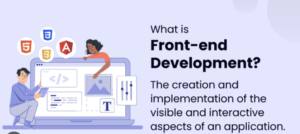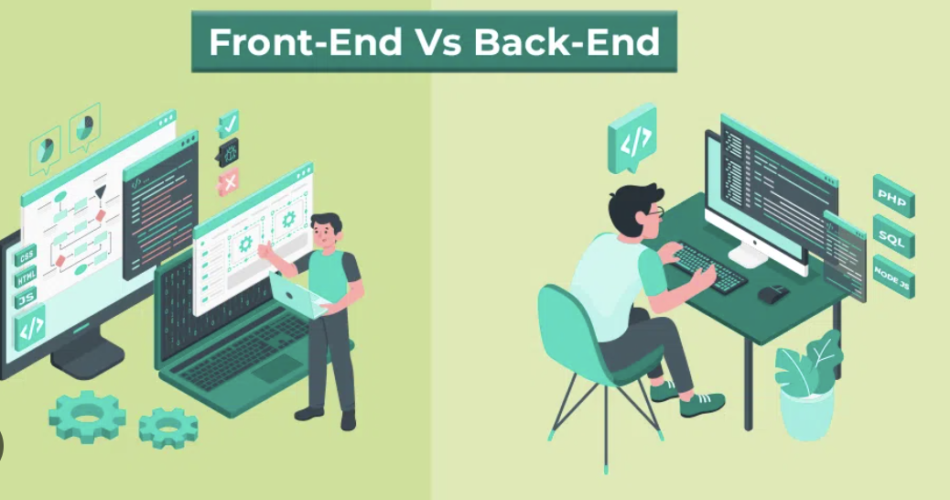Contents
- 1 Introduction to Front End and Back End Development
- 2 What is Front End Development?
- 3 What is Back End Development?
- 4 Key Differences Between Front End and Back End Development
- 5 Front End Development Tools and Technologies
- 6 Back End Development Tools and Technologies
- 7 Front End vs Back End: Which Path Should You Choose?
- 8 Front End vs Back End Salaries and Job Prospects
- 9 How to Get Started with Front End or Back End Development
- 10 Conclusion: Making the Right Choice for Your Career in Web Development
Introduction to Front End and Back End Development
In the world of web development, there is a fundamental divide between back end and front end development. These two distinct disciplines work hand-in-hand to create the seamless and interactive experiences we enjoy on the internet. Understanding the key differences between front end and back end development is crucial for aspiring web developers, as it can help them make an informed decision about their career path.

front end development
Front end development and back end development are like the two sides of a coin – they complement each other to form a complete web application. While front end developers focus on the visual and interactive aspects of a website or web application, back end developers are responsible for the behind-the-scenes logic and server-side functionality.
What is Front End Development?
Front end development is the process of creating the user interface (UI) and user experience (UX) of a website or web application. Front end developers are responsible for translating the design and layout of a website into a functional and visually appealing user interface. They use a combination of HTML, CSS, and JavaScript to create the front-facing elements that users interact with, such as buttons, menus, forms, and animations.
Front end developers must have a strong understanding of web standards, user experience principles, and responsive design to ensure that the website or web application looks and functions seamlessly across different devices and screen sizes. They also need to be proficient in various front end frameworks and libraries, such as React, Angular, and Vue.js, to build complex and dynamic user interfaces.
What is Back End Development?
Back end development, on the other hand, focuses on the server-side of a web application. Back end developers are responsible for building the underlying infrastructure and logic that powers the website or web application. This includes tasks such as:
- Designing and implementing the database schema to store and manage data.
- Building the application logic and business rules that handle user requests and generate dynamic content.
- Developing APIs (Application Programming Interfaces) to facilitate communication between the front end and the back end.
- Implementing security measures to protect the application and its data from unauthorized access.
- Deploying and maintaining the server-side infrastructure, including web servers, application servers, and cloud services.
Back end developers typically use server-side programming languages like Python, Java, PHP, or Ruby, along with frameworks and libraries such as Django, Spring, Laravel, or Ruby on Rails, to build the back end of a web application.
Key Differences Between Front End and Back End Development
While front end and back end development are interconnected, there are several key differences between the two:
- Focus: Front end development focuses on the user-facing aspects of a website or web application, while back end development focuses on the server-side logic and infrastructure.
- Languages and Technologies: Front end development primarily uses HTML, CSS, and JavaScript, while back end development utilizes server-side programming languages like Python, Java, PHP, or Ruby.
- Responsibilities: Front end developers are responsible for creating the user interface and ensuring a seamless user experience, while back end developers are responsible for building the underlying functionality and data management.
- Deployment: Front end code is deployed to the user’s web browser, while back end code is deployed to the server.
- Visibility: Front end code is visible to the user and can be inspected using browser developer tools, while back end code is hidden from the user and runs on the server.
- Complexity: Back end development is generally considered more complex, as it involves tasks such as database management, server configuration, and security implementation.
Front End Development Tools and Technologies
Front end development relies on a variety of tools and technologies to create the user interface and user experience of a website or web application. Some of the most commonly used front end development tools and technologies include:
- HTML (Hypertext Markup Language): The standard markup language used to create the structure and content of web pages.
- CSS (Cascading Style Sheets): The language used to control the visual presentation and styling of web pages.
- JavaScript: The programming language used to add interactivity, animations, and dynamic functionality to web pages.
- Front End Frameworks: Popular front end frameworks like React, Angular, and Vue.js, which provide a structured and efficient way to build complex user interfaces.
- CSS Preprocessors: Tools like Sass, Less, and Stylus, which extend the functionality of CSS and make it easier to write and maintain.
- Task Runners and Build Tools: Tools like Gulp, Grunt, and webpack, which automate various development tasks, such as compiling code, optimizing assets, and setting up development environments.
- Code Editors: Integrated Development Environments (IDEs) and text editors like Visual Studio Code, Sublime Text, and Atom, which provide a powerful and efficient coding environment.
- Browser Developer Tools: Built-in tools in web browsers, such as the Chrome DevTools and Firefox Developer Tools, which allow developers to inspect, debug, and optimize their front end code.
Back End Development Tools and Technologies
Back end development requires a different set of tools and technologies to build the server-side infrastructure and logic of a web application. Some of the most commonly used back end development tools and technologies include:
- Server-Side Programming Languages: Languages like Python, Java, PHP, Ruby, and Node.js, which are used to write the server-side code that powers the web application.
- Web Frameworks: Popular back end frameworks like Django, Spring, Laravel, and Ruby on Rails, which provide a structured and efficient way to build server-side applications.
- Database Management Systems: Relational databases like MySQL, PostgreSQL, and Oracle, as well as NoSQL databases like MongoDB and Cassandra, which are used to store and manage the data for the web application.
- Web Servers: Software like Apache, Nginx, and IIS, which are responsible for handling and responding to client requests.
- Application Servers: Platforms like Tomcat, JBoss, and Glassfish, which provide a runtime environment for server-side applications.
- Cloud Services: Cloud platforms like Amazon Web Services (AWS), Microsoft Azure, and Google Cloud, which offer a range of scalable and managed services for hosting and deploying back end infrastructure.
- Version Control Systems: Tools like Git and Subversion, which are used to manage and collaborate on the source code for the back end application.
- Deployment and Automation Tools: Tools like Ansible, Puppet, and Chef, which automate the deployment and configuration of the back end infrastructure.
Front End vs Back End: Which Path Should You Choose?
Choosing between front end and back end development as a career path depends on your personal interests, skills, and goals. Here are some factors to consider:
- Interests and Strengths: If you have a strong interest in user interface design, user experience, and creating visually appealing and interactive web applications, front end development might be the better fit for you. If you’re more interested in building the underlying infrastructure and logic that powers a web application, back end development could be a better choice.
- Technical Skills: Front end development requires a strong understanding of HTML, CSS, and JavaScript, as well as familiarity with front end frameworks and libraries. Back end development requires proficiency in server-side programming languages, database management, and web server configuration.
- Problem-Solving Approach: Front end development often involves solving user-centric problems and ensuring a seamless user experience. Back end development typically involves solving more complex, infrastructure-related problems and implementing robust server-side functionality.
- Career Prospects and Salaries: Both front end and back end development offer promising career prospects and competitive salaries, but the specific job market and salary ranges can vary depending on your location, experience, and the specific technologies you specialize in.
Ultimately, the choice between front end and back end development depends on your personal preferences, skills, and career goals. Many successful web developers have experience in both front end and back end development, and some even specialize in full-stack development, which encompasses both disciplines.
Front End vs Back End Salaries and Job Prospects
The salaries and job prospects for front end and back end developers can vary depending on several factors, such as location, industry, experience, and the specific technologies and skills they possess.
| Metric | Front End Development | Back End Development |
|---|---|---|
| Median Salary (US) | $75,000 – $110,000 | $80,000 – $120,000 |
| Job Growth Outlook (US) | 13% (faster than average) | 15% (faster than average) |
| Top Hiring Companies | Tech giants, startups, agencies | Tech giants, enterprises, government |
| In-Demand Skills | HTML, CSS, JavaScript, React, Angular, Vue.js | Python, Java, PHP, Ruby, databases, APIs, cloud computing |
It’s important to note that these are general trends, and the actual salaries and job prospects can vary significantly based on the specific location, industry, and the individual’s experience and skill set.
How to Get Started with Front End or Back End Development
Regardless of whether you choose to pursue front end or back end development, the path to becoming a successful web developer typically involves the following steps:
- Learn the Fundamentals: Acquire a solid understanding of the core technologies and concepts in your chosen field, whether it’s front end (HTML, CSS, JavaScript) or back end (server-side programming languages, databases, web frameworks).
- Practice and Build Projects: Hands-on experience is crucial, so start building your own websites or web applications to apply what you’ve learned. This will help you develop a portfolio and showcase your skills.
- Stay Up-to-Date with Industry Trends: Web development is a rapidly evolving field, so it’s essential to stay informed about the latest tools, frameworks, and best practices in your chosen specialization.
- Gain Practical Experience: Consider internships, freelance work, or entry-level positions to gain practical experience and build your professional network.
- Continuously Learn and Improve: Web development is a lifelong learning process, so be prepared to continuously expand your knowledge and skills to stay competitive in the job market.
If you’re ready to take the next step in your web development career, consider enrolling in an online course or bootcamp that specializes in either front end or back end development. These programs can provide you with the comprehensive training and hands-on experience you need to succeed in your chosen field.
Conclusion: Making the Right Choice for Your Career in Web Development
Choosing between front end and back end development is a crucial decision that can significantly impact your career in web development. By understanding the key differences between these two disciplines, you can make an informed choice that aligns with your interests, skills, and career aspirations.
Whether you decide to specialize in front end or back end development, or even pursue a full-stack role that encompasses both, the web development industry offers abundant opportunities for growth and success. By continuously learning, building practical experience, and staying up-to-date with industry trends, you can position yourself for a fulfilling and rewarding career in the dynamic world of web developmen
